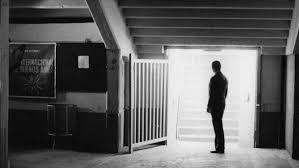

- Invasive Species. Foreword. -
Invasión, Hugo Santiago, Argentina, 1969, 123', 35mm, OV
What if a film brought together two of the great writers in the history of literature, Jorge Luis Borges and Adolfo Bioy Casares, for the script, and the visual talent of an avant-garde film-maker and pioneer of the Argentine new wave like Hugo Santiago? That is what happened with this film, an absolute cult classic.
We must also remember than this is a work that was on the point of disappearing forever: shot at the end of the military dictatorship of Juan Carlos Onganía, the film was sequestered after the military coup of 1976, and was missing for many years, something that added to its aura as a mythical event in the world of film. In 2004, a 35mm copy was found, and this allowed the Filmoteca Buenos Aires to recover this key work and redistribute the film to cinemas around the world. And now we are presenting it in Tabakalera as a prologue to our summer cinema season in the Cristina Enea Park, which this year revolves around the idea of invasive species.
The year is 1957, and we are in the city of Aquilea (an invented name for a city that could be Buenos Aires). A group of invaders that we hardly know anything about attempt to take the city. A resistance group, commanded by an old man, try to stop that invasion. Everything is dark, mysterious, unreal, and impossible to define. Who are they, where do they come from, what do they want? This is a multifaceted film: a labyrinth film, a mirror film, an allegorical film that is at the same time crime thriller, science fiction, avant-garde and a film with a political argument.
At this point it is worth reminding ourselves of other classics of the genre in order to help us to assess the magnitude, the importance of this film in the context of the history of cinema: La jetée (1962) by Chris Marker and Alphaville (1965) by Jean-Luc Godard share an epoch and an existential, poetic and tragic portrait of a future/past society. And, of course, we must also mention El Eternauta (The Eternaut), the science fiction comic by Germán Oesterheld and the cartoonist Francisco Solano López that was published between 1957 and 1959 and that began with an invasion of the city of Buenos Aires.
This screening in our cinema serves as a tribute to Hugo Santiago, who died in February this year after a life dedicated to cinema. Born in Buenos Aires, he was an author of cult works and secrecy. He was a disciple and assistant of Robert Bresson for seven years during his French period, and his career spanned both sides of the ocean, as was the case with many talented artists who lived in the turbulent era of the exiles. His film, as with all good political art, is still as relevant as ever and it is an honour to screen it in our cinema.
“It is a fantastic film and a kind of fantasy that might be described as new. It is not scientific fiction in the manner of Wells or Bradbury. Nor are there supernatural elements: the invaders do not come from another world. Nor is it psychologically fantastic: the characters do not act in a way that is contrary to the general behaviour of men, as is often the case in the works of Henry James or Kafka. It is a fantastic situation: the situation of a city that is besieged by powerful enemies and defended – we do not know why – by a group of civilians.
We have tried, I do not know with what success, to make a new type of fantastic film: a film based on a situation that does not occur in reality, but that must, however, be accepted by the imagination of the spectator.”
Jorge Luis Borges.
Special mention at the Locarno International Film Festival, 1969.
Best script in the Asociación de Cronistas Cinematográficos of Argentina awards, 1970.
This screening in our cinema serves as a tribute to Hugo Santiago, who died in February this year after a life dedicated to cinema.
